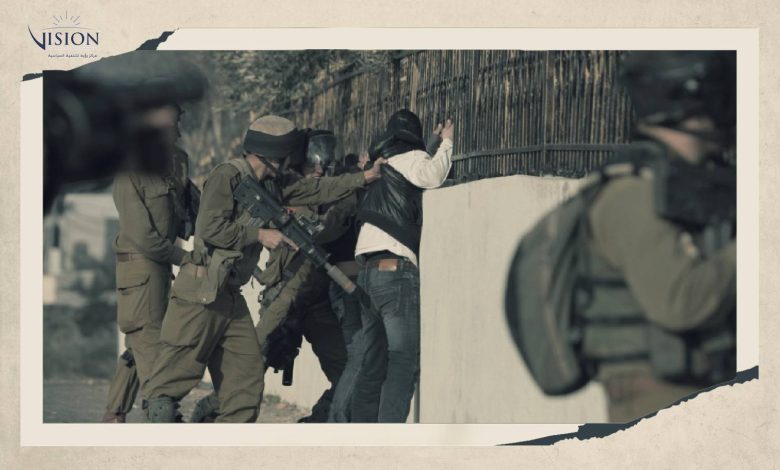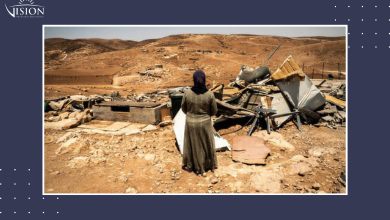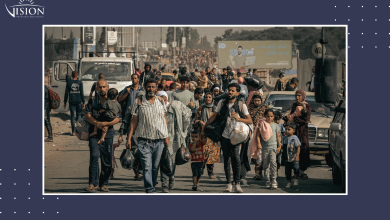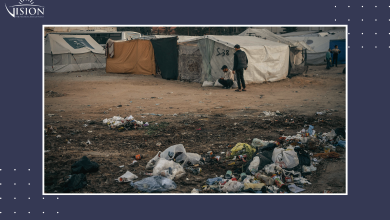Israeli Military Operations and Arrest Campaigns in the West Bank: An Analysis of Implications and Objectives

Sulaiman Bisharat[1]
In conjunction with the offensive on the Gaza Strip, the “Israeli” occupation forces escalated their measures in the West Bank to an unprecedented degree. These measures included the implementation of extensive daily arrest campaigns, the closure of the majority of main roads connecting the provinces, and the placement of earthen barriers, concrete cubes, and iron gates, all strategically positioned to facilitate the fragmentation of the West Bank.
These measures, unparalleled in their intensity and scale, coincided also with military operations, the demolition of homes, and the killing of Palestinians in the West Bank. This raises the question: Are these actions part of a calculated “Israeli” strategy to achieve specific objectives? Or as a result of a state of disarray within the occupation, following the repercussions of the “Al-Aqsa Flood” operation?
Intensive Arrest Campaigns:
On Saturday, October 21, the Palestinian Prisoner’s Society released that since October 7, the occupying forces had detained over 1,000 Palestinians in the West Bank. The campaign targeted influential figures, including leadership and political personalities, notably Aziz Dweik – chair of the Legislative Council, members of the Council, and former prisoners. The majority of detainees were associated with Hamas movement or the resistance, in addition to journalists and social media activists. This campaign started primarily in the Hebron governorate, subsequently extended to Bethlehem, Ramallah, and the other parts of the West Bank, in which 100 to 120 Palestinian citizens are detained on daily basis.
In addition to detentions conducted in the West Bank, the occupying forces have initiated an extensive arrest campaign targeting approximately 4,000 Palestinian workers from the Gaza Strip who were employed within the territories occupied in 1948. The Palestinian Prisoners’ Society has indicated that the number of Palestinian prisoners within the occupation’s jails has surged from around 5,000 prior to the “Al-Aqsa Intifada” to currently nearly 10,000. Furthermore, the administration of the occupation’s prisons has imposed sanctions on these detainees and widely violated their rights.
At dawn on Thursday, October 19th, Israeli occupying forces launched a significant military operation in the Nur Shams refugee camp in the Tulkarm Governorate. This operation bears a striking resemblance to a military action carried out approximately two months ago in the Jenin refugee camp, as part of its efforts to dismantle the Tulkarm battalion, which comprises combatants from various factions, notably including Hamas, Islamic Jihad, and the Al-Aqsa Martyrs’ Brigades. Over the 48-hour span of the military operation, 13 individuals were killed, the majority of whom were civilians and children. The occupation’s actions resulted in extensive destruction to the camp’s infrastructure, the demolition of numerous civilian vehicles, and significant damage to homes. Consequently, the number of causalities in the West Bank since October 7th has risen to 83, with 1,400 injured, according to the Palestinian Ministry of Health.
In the early hours of October 7, the occupying forces rapidly imposed a comprehensive blockade across the West Bank, coupled with the closure of the sole passage for travel via Jordan. Concurrently, they commenced the erection of earthen barriers, concrete cubes, and iron gates at the entrances of cities. Additionally, dozens of military checkpoints were established on main roads and dirt paths to severely restrict the movement of Palestinian citizens, effectively creating a kind of siege in the West Bank.
The Westbank has witnessed a critical depletion of fuel in the majority of petrol stations. This can represent a warning alarm of the possibility of preventing the supply of essential goods to the West Bank, where the occupation is completely control the transportation and ports.
All of these actions were ostensibly designed to thwart any civil mobilization concurrent with the launch of the “Deluge of Al-Aqsa” campaign. Despite these preventive measures, demonstrations opposing the war on the Gaza Strip continued in Palestinian cities and towns. These urban centers witnessed a surge of protest actions and marches in response to calls from political factions, civil society organizations, and individual activists. Some of these peaceful protests escalated into clashes at Israeli checkpoints.
Multiple Israeli Objectives:
In an attempt to comprehend the escalating Israeli behavior in the West Bank concurrent with the war on Gaza, several considerations can be taken into account:
Firstly, the geographical interconnection and the fear form the expansion of resistance: The daily arrest campaigns reveal the occupier’s focus on detentions particularly in the southern West Bank and specifically in the Hebron governorate, which is geographically closest to the Gaza Strip. This could be interpreted as Israeli concern that the movement of resistance fighters from Gaza, as witnessed on October 7th, could potentially enable some of these groups to reach Hebron or its geographical extension in the future.
Secondly, Restoring Confidence: Following a discernible erosion in their self-assurance, as documented by video footage published by the resistance during their raids on settlements in the Gaza periphery, the occupation soldiers, who raid civilian homes in the West Bank during daily arrest operations, have physically assaulted the detainees, subjecting them to verbal abuse, and attempting to mimic the actions of resistance fighters, such as stepping on the heads of the detained.
Thirdly, Reinforcing the Israeli Deterrence Strategy: Many analyses suggest that the Israeli deterrence theory was significantly weakened following the “Deluge of Al-Aqsa” battle. This shift is a growing concern for the occupation in the West Bank, prompting it to undertake a series of pre-emptive measures, including imposing a partial lockdown, and demonstrating force through an increased frequency of targeted killings, arrests, home demolitions, and military operations.
Fourthly, undermining mass reaction and escalation by neutralizing leaders or influencers: Any mass mobilization in the West Bank without the presence of leadership or influential figures to guide the movement remains merely a reflexive action, lacking the capability to instigate a state of disciplined organization. This is what Israel has sought in the context of a political decision-making vacuum from the Palestinian leadership, the absence of the Palestine Liberation Organization (PLO) and popular factions, particularly Fatah. This leaves the masses to participate in activities as a form of internal release rather than transitioning into a structured model within an escalating mass strategy.
Fifthly, Diminishing or Weakening Inspirational Models: The Israeli occupation recognizes that the transformation of this resistance model into an inspirational phenomenon in the West Bank, particularly in the prevailing environment amidst the aggression on the Gaza Strip, has the potential to evolve in terms of performance and geographic expansion. Consequently, Israel seized the opportunity to pounce on the Nur Shams Camp and inflicting significant damage, thus preoccupying the people with reorganizing their necessities.
Sixthly, Maintaining the Current Political Status in the West Bank: it witnessed protests demanding the Palestinian Authority to take an action or engage directly in confrontation. These developments recalled the Israelis with the events of the Second Palestinian Intifada and the Tunnel uprising, where the involvement of Palestinian security personnel had significant implications for the evolution of the field situation and the mode of confrontation.
In summary:
The Israeli occupation understands that the West Bank constitutes a significant human reserve that could fundamentally alter the dynamics of confrontation, a scenario Israel is keen to avoid. To this end, Israel is attempting to increase the “cost of resistance.” This is achieved through the widespread detentions of Palestinian citizens, there is an intent to use these prisoners as bargaining chips in future negotiations, particularly if discussions commence regarding a prisoner exchange deal, where Palestinian detainees could be traded for those held by the resistance factions in the Gaza Strip.
[1] – A researcher at Yabous Institute for Consultations and Strategic Studies, Ramallah.




